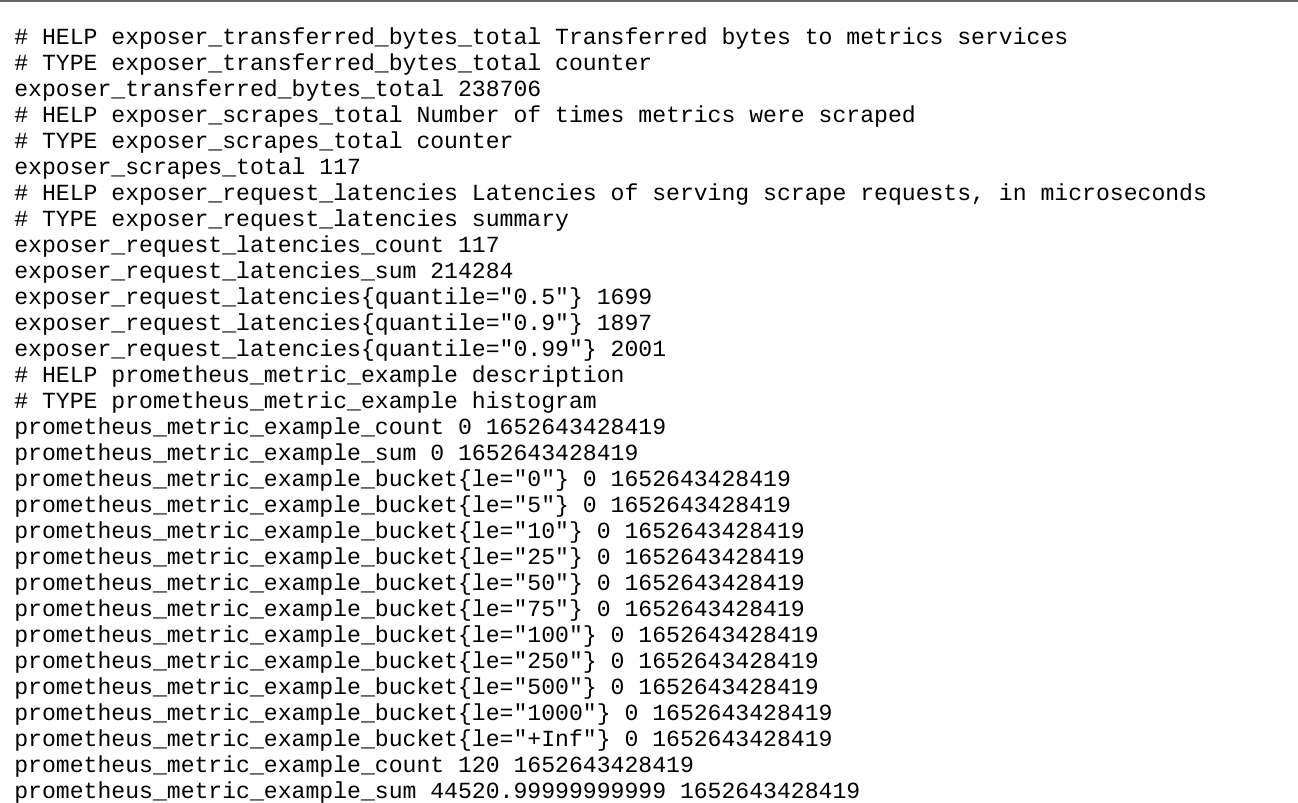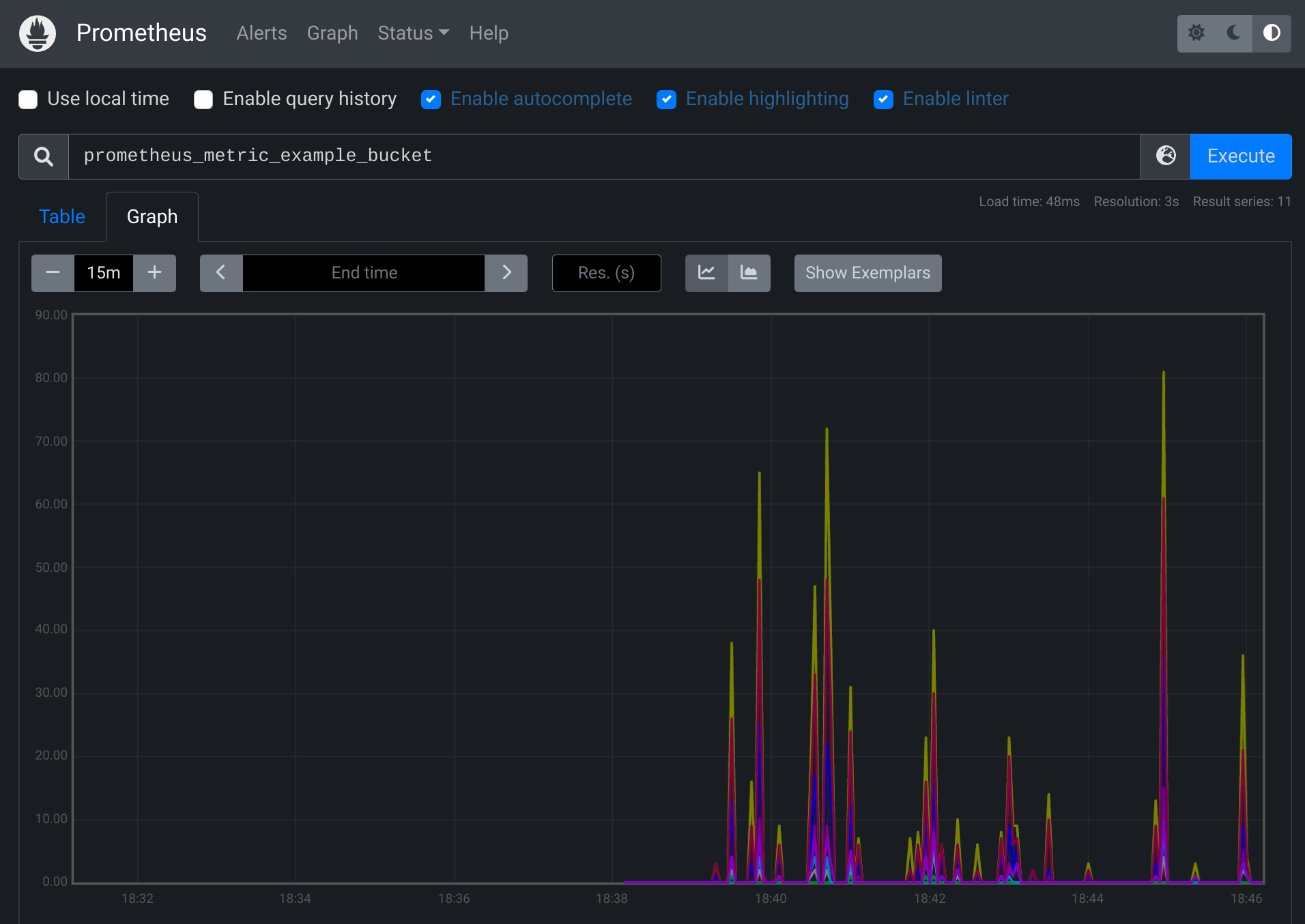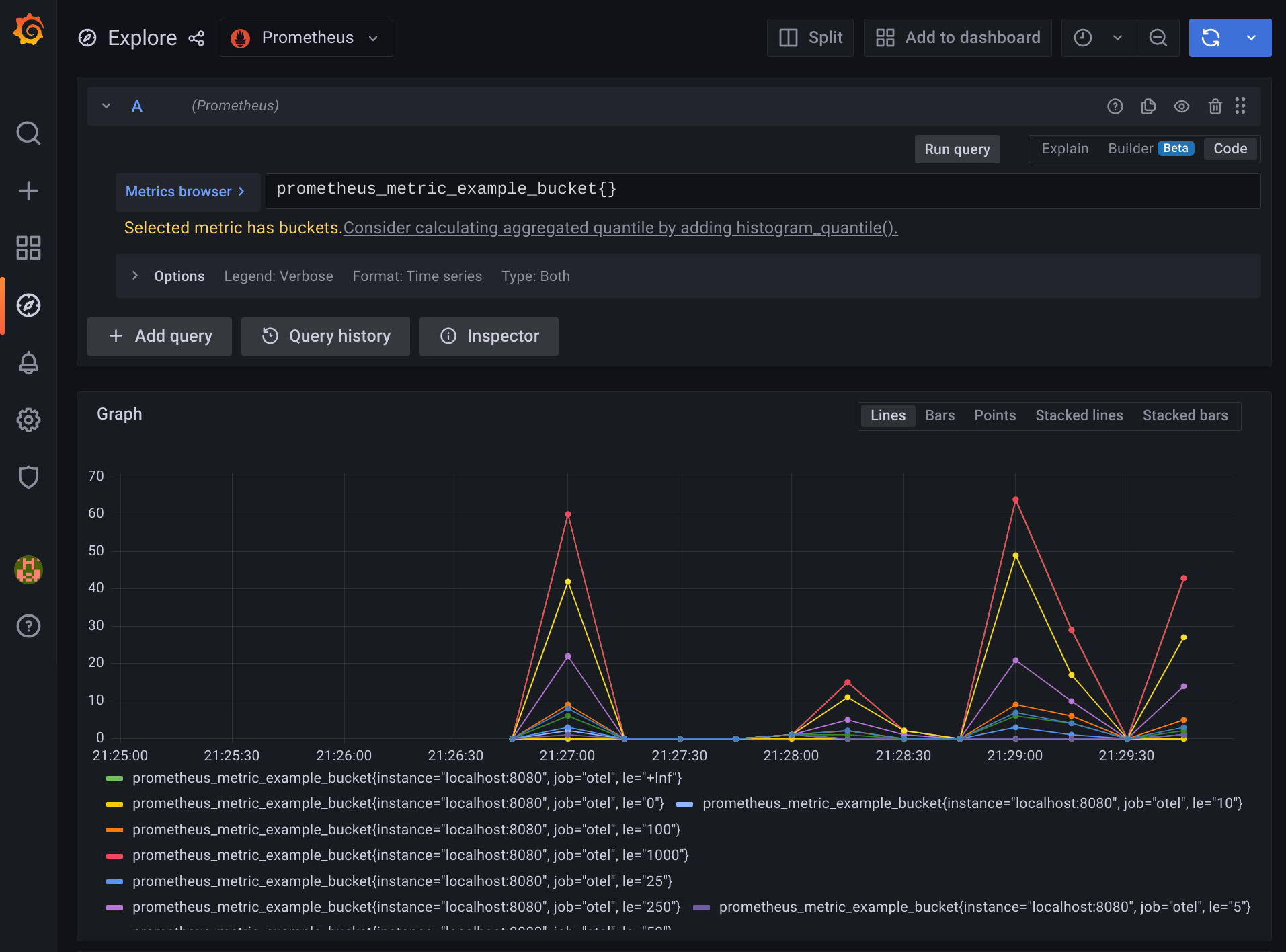-
Notifications
You must be signed in to change notification settings - Fork 449
New issue
Have a question about this project? Sign up for a free GitHub account to open an issue and contact its maintainers and the community.
By clicking “Sign up for GitHub”, you agree to our terms of service and privacy statement. We’ll occasionally send you account related emails.
Already on GitHub? Sign in to your account
Document Getting Started with Prometheus and Grafana #1396
Changes from 8 commits
e7a01cc
5060893
eeb6e86
d173c52
28f65d7
eb3e4eb
4749aa9
e848041
e5761f7
30e042c
d959efe
a1f882b
c4a0c61
47a5fb2
6748870
8fd07bd
File filter
Filter by extension
Conversations
Jump to
Diff view
Diff view
There are no files selected for viewing
| Original file line number | Diff line number | Diff line change | ||||
|---|---|---|---|---|---|---|
| @@ -0,0 +1,211 @@ | ||||||
| # Getting Started with Prometheus and Grafana | ||||||
|
|
||||||
| - [Export metrics from the application](#export-metrics-from-the-application) | ||||||
| - [Check results in the browser](#check-results-in-the-browser) | ||||||
| - [Collect metrics using Prometheus](#collect-metrics-using-prometheus) | ||||||
| - [Configuration](#configuration) | ||||||
| - [Start Prometheus](#start-prometheus) | ||||||
| - [View results in Prometheus](#view-results-in-prometheus) | ||||||
| - [Explore metrics using Grafana](#explore-metrics-using-grafana) | ||||||
| - [Learn more](#learn-more) | ||||||
|
|
||||||
| ## Export metrics from the application | ||||||
|
|
||||||
| It is highly recommended to go over the [ostream-metrics](../metrics_simple/README.md) | ||||||
| doc before following along this document. | ||||||
|
|
||||||
| Create a new console application and run it: | ||||||
|
|
||||||
| ```sh | ||||||
| bazel run //examples/prometheus:prometheus_example | ||||||
| ``` | ||||||
|
|
||||||
| Now, we are going to make some small tweaks to the example in the | ||||||
| ostream-metrics to make the metrics available via | ||||||
| OpenTelemetry Prometheus Exporter. | ||||||
|
|
||||||
| And replace the below line: | ||||||
|
|
||||||
| ```cpp | ||||||
| std::unique_ptr<metric_sdk::MetricExporter> exporter{ | ||||||
| new exportermetrics::OStreamMetricExporter}; | ||||||
|
|
||||||
| ``` | ||||||
|
|
||||||
| with | ||||||
|
|
||||||
| ```cpp | ||||||
| std::unique_ptr<metrics_sdk::MetricExporter> exporter{ | ||||||
| new metrics_exporter::PrometheusExporter(opts)}; | ||||||
| ``` | ||||||
|
|
||||||
| OpenTelemetry `PrometheusExporter` will export | ||||||
| data via the endpoint defined by | ||||||
| `metrics_exporter::PrometheusExporterOptions::url`, | ||||||
| which is `http://localhost:8080/` by default. | ||||||
|
There was a problem hiding this comment. Choose a reason for hiding this commentThe reason will be displayed to describe this comment to others. Learn more. Not directly related to this PR, consider changing the default port following https://github.com/open-telemetry/opentelemetry-specification/blob/main/specification/sdk-environment-variables.md#prometheus-exporter (note that the spec is still Experimental). There was a problem hiding this comment. Choose a reason for hiding this commentThe reason will be displayed to describe this comment to others. Learn more. thanks, I fixed the port. |
||||||
|
|
||||||
| ```mermaid | ||||||
| graph LR | ||||||
|
|
||||||
| subgraph SDK | ||||||
| MeterProvider | ||||||
| MetricReader[PeriodicExportingMetricReader] | ||||||
| PrometheusExporter["PrometheusExporter<br/>(http://localhost:8080/)"] | ||||||
| end | ||||||
|
|
||||||
| subgraph API | ||||||
| Instrument["Meter(#quot;prometheus_metric_example#quot;, #quot;1.0#quot;)<br/>Histogram(#quot;prometheus_metric_example_histogram#quot;)"] | ||||||
| end | ||||||
|
|
||||||
| Instrument --> | Measurements | MeterProvider | ||||||
|
|
||||||
| MeterProvider --> | Metrics | MetricReader --> | Pull | PrometheusExporter | ||||||
| ``` | ||||||
|
|
||||||
| Also, for our learning purpose, use a while-loop to keep recoring random | ||||||
| values until the program stopped. | ||||||
|
|
||||||
| ```cpp | ||||||
| while (true) | ||||||
| { | ||||||
| double val = (rand() % 700) + 1.1; | ||||||
| std::map<std::string, std::string> labels = get_random_attr(); | ||||||
| auto labelkv = opentelemetry::common::KeyValueIterableView<decltype(labels)>{labels}; | ||||||
| histogram_counter->Record(val, labelkv, context); | ||||||
| std::this_thread::sleep_for(std::chrono::milliseconds(50)); | ||||||
| } | ||||||
| ``` | ||||||
|
|
||||||
| ### Check results in the browser | ||||||
|
|
||||||
| Start the application and keep it running. Now we should be able to see the | ||||||
| metrics at [http://localhost:8080/metrics](http://localhost:9464/metrics) from a | ||||||
| web browser: | ||||||
|
|
||||||
|  | ||||||
|
|
||||||
| Now, we understand how we can configure `PrometheusExporter` to export metrics. | ||||||
| Next, we are going to learn about how to use Prometheus to collect the metrics. | ||||||
|
|
||||||
| ## Collect metrics using Prometheus | ||||||
|
|
||||||
| Follow the [first steps](https://prometheus.io/docs/introduction/first_steps/) | ||||||
| to download the [latest release](https://prometheus.io/download/) of Prometheus. | ||||||
|
|
||||||
| ### Configuration | ||||||
|
|
||||||
| After finished downloading, extract it to a local location that's easy to | ||||||
esigo marked this conversation as resolved.
Show resolved
Hide resolved
|
||||||
| access. We will find the default Prometheus configuration YAML file in the | ||||||
| folder, named `prometheus.yml`. | ||||||
|
|
||||||
| Let's create a new file in the same location as where `prometheus.yml`. Then, | ||||||
| copy and paste the entire content below into the `prometheus.yml` file | ||||||
| we have created just now. | ||||||
|
|
||||||
| ```yaml | ||||||
| global: | ||||||
| scrape_interval: 5s | ||||||
| scrape_timeout: 2s | ||||||
| evaluation_interval: 5s | ||||||
| alerting: | ||||||
| alertmanagers: | ||||||
| - follow_redirects: true | ||||||
| scheme: http | ||||||
| timeout: 5s | ||||||
| api_version: v2 | ||||||
| static_configs: | ||||||
| - targets: [localhost:8080] | ||||||
| scrape_configs: | ||||||
| - job_name: otel | ||||||
| static_configs: | ||||||
| - targets: ['localhost:8080'] | ||||||
| ``` | ||||||
|
|
||||||
| ### Start Prometheus | ||||||
|
|
||||||
| Follow the instructions from | ||||||
| [starting-prometheus](https://prometheus.io/docs/introduction/first_steps/#starting-prometheus) | ||||||
| to start the Prometheus server and verify it has been started successfully. | ||||||
|
|
||||||
| Please note that we will need pass in `prometheus.yml` file as the argument | ||||||
| or mount as volume: | ||||||
|
|
||||||
| ```console | ||||||
| docker run -p 9090:9090 -v $(pwd):/etc/prometheus --network="host" prom/prometheus | ||||||
| ``` | ||||||
|
|
||||||
| ### View results in Prometheus | ||||||
|
|
||||||
| To use the graphical interface for viewing our metrics with Prometheus, navigate | ||||||
| to [http://localhost:9090/graph](http://localhost:9090/graph), | ||||||
| and type `prometheus_metric_example_bucket` in the expression bar of the UI; | ||||||
| finally, click the execute button. | ||||||
|
|
||||||
| We should be able to see the following chart from the browser: | ||||||
|
|
||||||
|  | ||||||
|
|
||||||
| From the legend, we can see that the `instance` name and the `job` name are the | ||||||
| values we have set in `prometheus.yml`. | ||||||
|
|
||||||
| Congratulations! | ||||||
|
|
||||||
| Now we know how to configure Prometheus server and deploy OpenTelemetry | ||||||
| `PrometheusExporter` to export our metrics. Next, we are going to explore a tool | ||||||
| called Grafana, which has powerful visualizations for the metrics. | ||||||
|
|
||||||
| ## Explore metrics using Grafana | ||||||
|
|
||||||
| [Install Grafana](https://grafana.com/docs/grafana/latest/installation/). | ||||||
|
|
||||||
| Start the standalone Grafana server (`grafana-server.exe` or | ||||||
| `./bin/grafana-server`, depending on the operating system). Then, use the | ||||||
| browser to navigate to [http://localhost:3000/](http://localhost:3000/). | ||||||
|
|
||||||
| ```sh | ||||||
| docker run -d -p 3000:3000 --network="host" grafana/grafana | ||||||
| ``` | ||||||
|
|
||||||
| Follow the instructions in the Grafana getting started | ||||||
| [doc](https://grafana.com/docs/grafana/latest/getting-started/getting-started/#step-2-log-in) | ||||||
| to log in. | ||||||
|
|
||||||
| After successfully logging in, click on the Configuration icon | ||||||
| on the panel at the left hand side, and click on Prometheus. | ||||||
| Type in the default endpoint of Prometheus as suggested by the UI | ||||||
| as the value for the URI. | ||||||
|
|
||||||
| ```console | ||||||
| http://localhost:9090 | ||||||
| ``` | ||||||
|
|
||||||
| Then, click on the Explore icon on the left panel of | ||||||
| the website - we should be able to write some queries to explore our metrics | ||||||
| now! | ||||||
|
|
||||||
| Feel free to find some handy PromQL | ||||||
| [here](https://promlabs.com/promql-cheat-sheet/). | ||||||
|
|
||||||
|  | ||||||
|
|
||||||
| ```mermaid | ||||||
| graph TD | ||||||
|
|
||||||
| subgraph Prometheus | ||||||
| PrometheusScraper | ||||||
| PrometheusDatabase | ||||||
| end | ||||||
|
|
||||||
| PrometheusExporter["PrometheusExporter<br/>(listening at #quot;http://localhost:8080/#quot;)"] -->|HTTP GET| PrometheusScraper{{"Prometheus scraper<br/>(polling #quot;http://localhost:8080/metrics#quot; every 10 seconds)"}} | ||||||
|
There was a problem hiding this comment. Choose a reason for hiding this commentThe reason will be displayed to describe this comment to others. Learn more.
Suggested change
|
||||||
| PrometheusScraper --> PrometheusDatabase[("Prometheus TSDB (time series database)")] | ||||||
| PrometheusDatabase -->|http://localhost:9090/graph| PrometheusUI["Browser<br/>(Prometheus Dashboard)"] | ||||||
| PrometheusDatabase -->|http://localhost:9090/api/| Grafana[Grafana Server] | ||||||
| Grafana -->|http://localhost:3000/dashboard| GrafanaUI["Browser<br/>(Grafana Dashboard)"] | ||||||
| ``` | ||||||
|
|
||||||
| ## Learn more | ||||||
|
|
||||||
| - [What is Prometheus?](https://prometheus.io/docs/introduction/overview/) | ||||||
| - [Grafana support for | ||||||
| Prometheus](https://prometheus.io/docs/visualization/grafana/#creating-a-prometheus-graph) | ||||||
There was a problem hiding this comment.
Choose a reason for hiding this comment
The reason will be displayed to describe this comment to others. Learn more.
Should we be making these changes in the example before running it?There was a problem hiding this comment.
Choose a reason for hiding this comment
The reason will be displayed to describe this comment to others. Learn more.
Sorry if I am missing something. Why do we need to modify ostream-metrics to export to Prometheus Exporter - the above step of running prometheus_example should already do the metrics export?
There was a problem hiding this comment.
Choose a reason for hiding this comment
The reason will be displayed to describe this comment to others. Learn more.
thanks, it is not needed to do anything extra here. I changed the wording to make it clear.